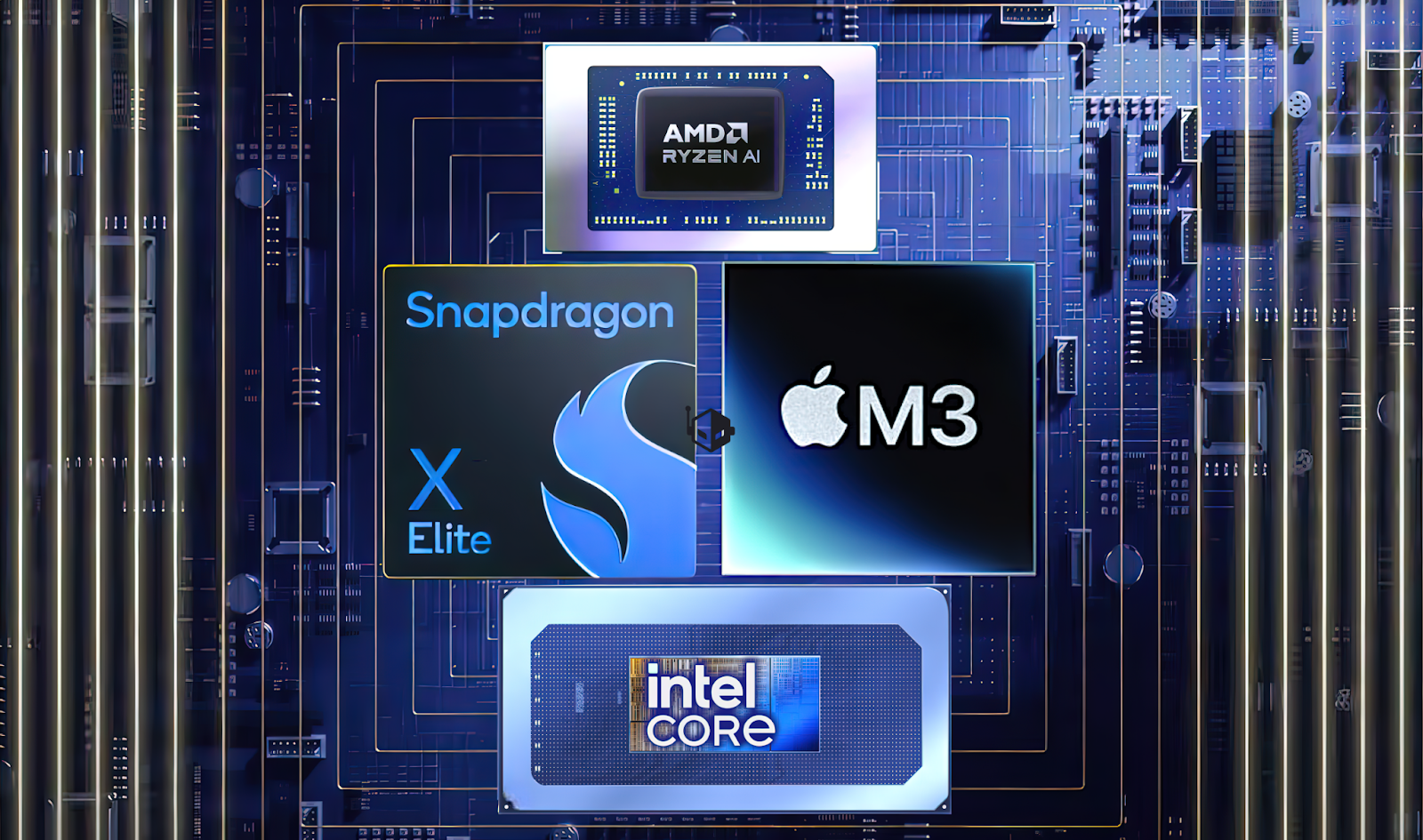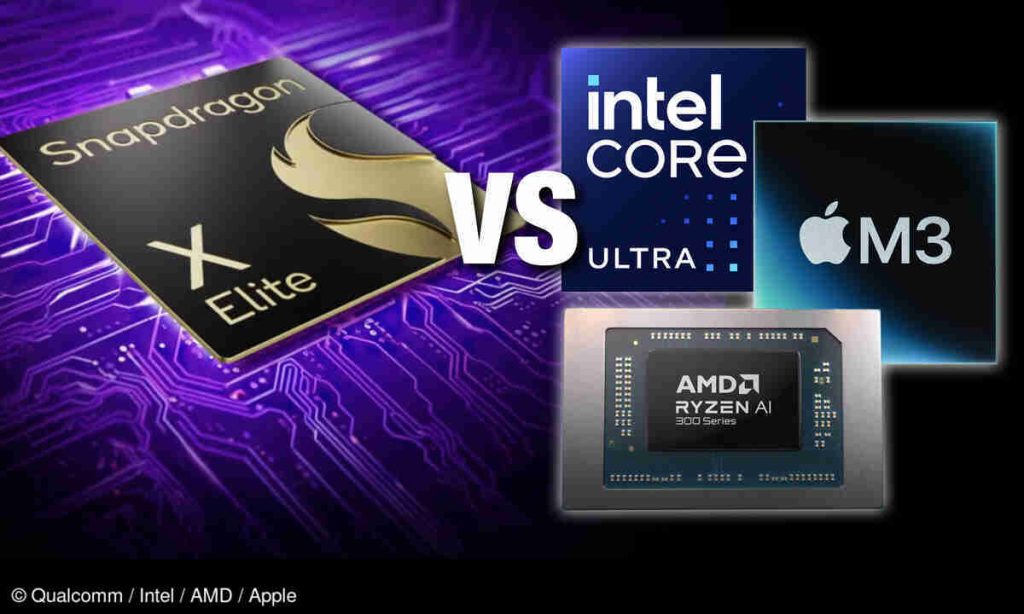
The Ultimate Showdown in Next-Gen Processors
As the digital world surges forward, the battlefield of silicon supremacy has never been fiercer. The four major titans—Apple, Intel, AMD, and Qualcomm—are locked in an arms race to craft the most powerful, efficient, and AI-driven processors of the decade. With significant advancements in performance, thermal management, and power consumption, the question looms large: Who reigns supreme in 2025?
The Contenders: A Quick Overview
- Apple M-Series: Apple’s proprietary ARM-based silicon, engineered for efficiency, power, and ecosystem optimization.
- Intel Core: The x86 juggernaut pushing innovation in hybrid core architectures and clock speed dominance.
- AMD Ryzen: The disruptor, bringing a balance of multi-core performance and efficiency.
- Qualcomm Snapdragon: The mobile-first leader now expanding into laptops, promising always-connected computing with ARM-based efficiency.
Chipset Performance Comparison: Who Holds the Crown?
Raw Power & Speed
Intel Core has long been the king of sheer clock speeds, leveraging its high-performance hybrid architecture to deliver unmatched single-threaded power. In 2025, Intel’s latest Core Ultra series boasts speeds exceeding 6 GHz, thanks to improved lithography and performance cores tailored for intensive computing. With the introduction of Intel’s 3D Foveros packaging, core densities have increased, improving computational throughput while managing heat more effectively.
On the other hand, AMD Ryzen, with its Zen 5 architecture, continues to dominate in multi-core workloads, offering incredible processing power for creators and gamers alike. AMD’s use of 3D V-Cache technology improves gaming and rendering performance, delivering higher frame rates and lower latency.
Meanwhile, Apple M-Series focuses on maximizing efficiency and integration, with the M3 Ultra chip reportedly achieving industry-leading performance-per-watt ratios. The M3 Ultra uses a 4nm process node, allowing for higher transistor density, reduced power consumption, and better AI acceleration.
Lastly, Qualcomm Snapdragon, traditionally a mobile processor giant, has now entered the laptop and desktop space with its Snapdragon X Elite series. Leveraging ARM-based architecture, it integrates Neural Processing Units (NPUs) for AI-driven tasks, enabling on-device machine learning without excessive power drain.
Benchmark Testing 2025: The Data Speaks
In independent tests:
- Intel Core Ultra 14 scored 2,300 in single-core Geekbench tests, leading in raw speed.
- AMD Ryzen 9000X delivered 30% better multi-threaded performance than its predecessor, perfect for power users.
- Apple M3 Ultra shocked the industry by outperforming many x86 competitors in real-world application benchmarks, especially in video editing and machine learning tasks.
- Qualcomm Snapdragon X Elite dominated in efficiency tests, enabling laptops to last over 24 hours on a single charge while offering strong mobile computing performance.
Gaming & Graphics Performance
For gamers, the choice of processor is a crucial decision, often dictated by GPU performance. AMD Ryzen and Intel Core still hold dominance in the gaming segment, mainly due to their compatibility with high-end discrete GPUs from NVIDIA and AMD’s own Radeon series.
However, Apple is making strides in this arena with the M3 Ultra GPU, which provides an integrated solution that challenges dedicated gaming setups. With hardware-accelerated ray tracing, MetalFX upscaling, and AI-driven rendering techniques, Apple’s GPU is becoming increasingly competitive.
Meanwhile, Qualcomm Snapdragon focuses more on mobile gaming, with its Adreno GPU optimized for power efficiency rather than raw performance. It excels in cloud gaming and emulation tasks, making it a viable choice for portable gaming enthusiasts.
Power Efficiency & Thermal Management: Who Runs Coolest?
While Intel and AMD have traditionally battled power-hungry architectures, Apple M-Series and Qualcomm Snapdragon stand out in power efficiency & thermal management. ARM-based processors, like Apple’s M3 and Qualcomm’s Snapdragon, require far less power, leading to better battery life and lower heat generation.
Intel, in response, has introduced Intel Power Balance Technology, dynamically shifting power to cores that need it most, reducing heat buildup. Meanwhile, AMD’s Zen 5 chips use an optimized FinFET process to deliver high performance with improved thermals, making AMD’s new CPUs significantly more power-efficient than previous generations.
For ultra-portable and fanless designs, Apple and Qualcomm are clear winners, offering superior cooling solutions that make devices more compact, quieter, and longer-lasting.
AI and GPU Integration: The Future of Processing
AI is reshaping computing, and each brand is integrating AI accelerators directly into their chipsets.
- Apple M-Series leverages Neural Engine technology to power machine learning tasks at unmatched efficiency, making macOS AI-enhanced features lightning-fast.
- Intel Core Ultra integrates AI Boost, accelerating deep learning tasks, real-time video enhancement, and predictive computing.
- AMD Ryzen AI delivers enhanced on-chip AI processing, optimizing workflows for developers, streamers, and creative professionals.
- Qualcomm Snapdragon leads with dedicated NPU cores, making AI-powered features more responsive in mobile and lightweight devices.
Meanwhile, in the GPU battle, AMD and NVIDIA remain the top players for discrete graphics, but Apple’s M-Series GPU and Intel’s Xe Graphics are proving to be formidable integrated solutions. AI-driven image processing, frame interpolation, and real-time rendering optimizations will define the next era of gaming and creative computing.
Future of Computing: Who Will Lead the Next Decade?

With Next-Gen Processors evolving at breakneck speed, each manufacturer is aiming for dominance in distinct ways:
- Apple will continue pushing toward ARM-based computing, fully optimizing macOS for its silicon and leveraging AI/ML.
- Intel is banking on advanced hybrid architectures and expanding its presence in quantum and neuromorphic computing.
- AMD is leading in chiplet designs, ensuring scalability for both desktops, laptops, and data centers.
- Qualcomm is poised to revolutionize ARM-based laptops, aiming to challenge Apple directly in the ultra-portable computing space.
Beyond traditional computing, quantum computing, edge AI, and cloud-accelerated processing are areas where these manufacturers will continue to innovate. AI-powered automation, real-time rendering enhancements, and ultra-efficient processors will define the next computing era.
The Verdict: Who Rules 2025?
There is no one-size-fits-all winner. Intel dominates raw speed, AMD excels in multi-core performance, Apple rules efficiency, and Qualcomm leads in mobile innovation. The true winner? The consumers, as we enter an era where computing is faster, smarter, and more efficient than ever.
In the ever-evolving world of Next-Gen Processors, competition breeds innovation. Whether you’re a professional, a gamer, a content creator, or an everyday user, the future of computing has never looked more exciting.




